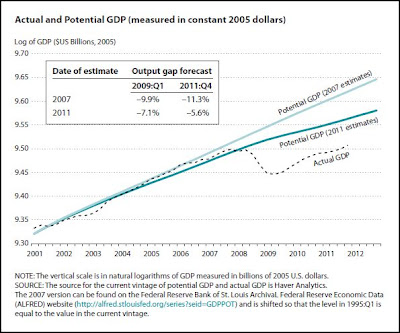The protagonist of the novel, Winston Smith, is a member of the Outer Party who works for the Ministry of Truth (Minitrue), which is responsible for propaganda and historical revisionism. His job is to re-write past newspaper articles so that the historical record always supports the current party line.
Let me start with the justification. In What Is Potential GDP and Why Does It Matter? (PDF, 2 pages), the Fed's Willian T. Gavin writes:
Looking back in time, potential output is relatively easy to measure because we have reliable methods to extract smooth trends from historical data. However, measuring potential output in real time is more difficult because only past data are available to estimate the trend.
PGDP is a trend line. As a trend, it must summarize the present and the future as accurately as it summarizes the past. But it is difficult to know the present trend, because it depends on the future. And it is even more difficult to know the future.
Fair enough. But what comes of these difficulties is a policy of historical revisionism:
 |
| Graph #1, Source: What Is Potential GDP and Why Does It Matter? (PDF) |
The estimate created in 2011 changes the past back to 2005 or before.

Recently, the Fed's David Altig showed a similar graph:
 |
| Graph #2, Source: Nature Abhors an Output Gap (Macroblog) |
Altig's graph begins in the first quarter of 2009.
For the estimate created in 2011, the value for 2009 is lower than the 2009 value from the estimate created in 2010. For the estimate created in 2012, the 2009 value is lower still. And the estimate created in 2013 shows an even lower value for 2009. Every year, we tell a different story about the past. We've always been at war with Eastasia.
Mr. Gavin's explanation notwithstanding, I'm not sure this practice is reasonable.

3 comments:
Irony abounds. Wikipedia is the new Ministry of Truth.
Could there be a causal relationship between a prolonged output gap and decaying potential (hysteresis?) that provides a not-so-Orwellian account of that revisionism?
"Wikipedia is the new Ministry of Truth.": Classic and profound!
Geerussell,
I am back-and-forth, and iffy on this. I have a lot of respect for the people who work those numbers. And I can see how a prolonged output gap might contribute to decaying potential. But it seems to me that today's prolonged output gap would harm tomorrow's potential, not yesterday's potential.
William Gavin's graph (above) shows the 2011 estimate not only below the 2007 estimate, but also below the actual. James Bullard puts that image into words, saying the economy was in a bubble then, and Potential really was below the actual... That's possible, but then graphs like Gavin's, at best, only serve to convey the concept. They are by no means evidence.
Post a Comment